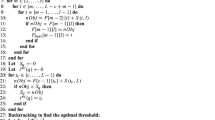Abstract
For the time being, the problem of detection of the faces of a small number of people observed from a short distance can be considered as solved, since any modern digital photographic camera or mobile phone can do that. In the present study, we consider extreme cases. A so-far open problem is that of detection of a large number of small-size objects that have fuzzy boundaries and may overlap. We solve this problem by using the stochastic multiple-birth-and-death (MBAD) algorithm, which has not previously been applied to detecting people in the images but has successfully been used in solving other computer-vision problems. The present study is devoted to the explanation of the basic principles of the algorithm operation and also to the description of its modifications intended for solving the problem of detection of faces in a dense crowd. In this study, in addition to the stochastic algorithm, we introduce a new detector for detection of fuzzy faces in the images, which is based on the same energy function that we use in the stochastic approach.
Similar content being viewed by others
References
P. J. Green, “Reversible Jump Markov Chain Monte Carlo Computation and Bayesian Model Determination,” Biometrika 82, 711–732 (1995).
X. Descombes, R. A. Minlos, and E. Zhizhina, “Object Extraction Using Stochastic Birth-and-Death Dynamics in Continuum,” J. Math. Imaging and Vision 33, 347 (2009).
X. Descombes and E. Zhizhina, “The Gibbs Fields Approach and Related Dynamics in Image Processing,” Condens. Matter Phys. 11(2), 1–20 (2008).
C. Benedek, X. Descombes, and J. Zerubia, “Building Extraction and Change Detection in Multitemporal Remotely Sensed Images with Multiple Birth and Death Dynamics,” in Workshop on Applications of Computer Vision-WACV, Snowbird, UT, USA, Dec. 7–8, 2009 (IEEE, New York, 2009), pp. 1–6.
M. Kulikova, I. Jermyn, X. Descombes, and J. Zerubia, “A Marked Point Process Model with Strong Prior Shape Information for the Extraction of Multiple, Arbitrarily-shaped Objects,” in Signal-Image Technology and Internet-Based Systems — SITIS’09 (Proc. 5th Int. Conf., Marrakech, Morocco, 29 Nov.–3 Dec., 2009 (IEEE, New York, 2009), pp. 180–186.
P. Cariou, X. Descombes, and E. Zhizhina, “A Point Process for Fully Automatic Road Network Detection in Satellite and Aerial Images,” Electron. J. Inf. Processes 10, 247–256 (2010).
P. Viola and M. Jones, “Robust Real-time Object Detection,” Int. J. Comp. Vision 57, 137–154 (2002).
A. Irshad and N. D. Matthew, “Multiple Human Tracking in High-density Crowds,” J. Image and Vision Comp. Archive 30, 966–977 (2012).
M. Rodriguez, I. Laptev, J. Sivic, and J. -Y. Audibert, “Density-aware Person Detection and Tracking in Crowds,” in Proc. IEEE Int. Conf. on Comp. Vision (ICCV), Barcelona, Spain, 2011 (IEEE, New York, 2011), pp. 2423–2430.
W. Ge and R. T. Collins, “Marked Point Processes for Crowd Counting,” in IEEE Conf. on Computer Vision and Pattern Recognition (CVPR), Miami, Florida, USA, June 20–25, 2009 (IEEE, New York, 2009), pp. 2913–2920.
C. Desai, D. Ramanan, and C. Fowlkes, “Discriminative Models for Multi-Class Object Layout,” in Proc. IEEE Int. Conf. on Comp. Vision (ICCV), Kyoto, Japan, Sept. 27–Oct. 4, 2009 (IEEE, New York, 2009).
A. Torralba, “Contextual Priming for Object Detection,” Int. J. Comp. Vision 53, 153–167 (2003).
X. Descombes and E. Zhizhina, “Double Annealing Regimes in the Multiple Birth-and-Death Stochastic Algorithms,” Markov Processes and Related Fields 18, 441–456 (2012).
S. Geman and D. Geman, “Stochastic Relaxation, Gibbs Distribution, and the Bayesian Restoration of Images,” IEEE Trans. Pattern. Anal. Mach. Intell. 6, 721–741 (1984).
H. Haario and E. Saksman, “Simulated Annealing Process in General State Space,” Adv. Appl. Probab. 23, 866–893 (1991).
M. N. M. Van Lieshout, “Stochastic Annealing for Nearest-Neighbour Point Processes with Application to Object Recognition,” Adv. Appl. Probab. 26, 281–300 (1994).
Cheng Yizong, “Mean Shift, Mode Seeking, and Clustering,” IEEE Trans. Pattern Anal. Mach. Intell. 17, 790–799 (1995).
Author information
Authors and Affiliations
Corresponding author
Additional information
Original Russian Text © D. Sidorchuk, E. Zhizhina, 2013, published in Informatsionnye Protsessy, 2013, Vol. 13, No. 2, pp. 171–184.
Rights and permissions
About this article
Cite this article
Sidorchuk, D., Zhizhina, E. Detection of fuzzy objects in color images with the use of stochastic algorithms. J. Commun. Technol. Electron. 59, 595–604 (2014). https://doi.org/10.1134/S1064226914060187
Received:
Published:
Issue Date:
DOI: https://doi.org/10.1134/S1064226914060187




